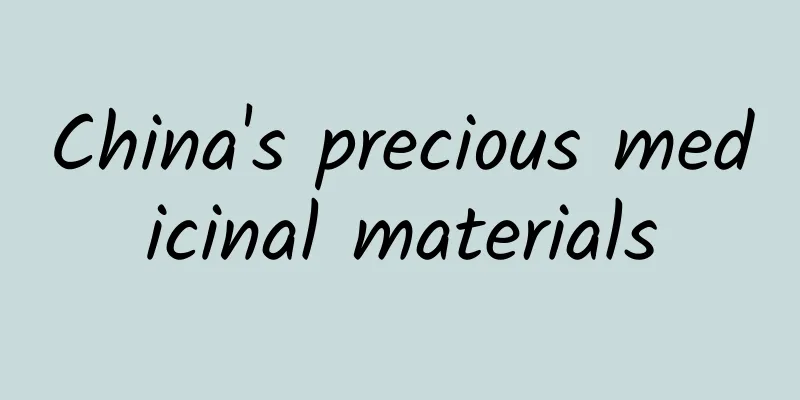China's precious medicinal materials

|
China is a vast country with rich resources. The geographical environment of each region is different, which leads to different plants growing in each region. Of course, there are many precious Chinese medicinal materials distributed in China, and most of these precious Chinese medicinal materials are distributed in plateau and mountainous areas. There is no doubt that the price of precious Chinese medicinal materials will be more expensive than ordinary Chinese medicinal materials, and their medicinal value will be more obvious. Today, let’s take a look at the types of precious Chinese medicinal materials. 1. Saffron This product is the upper part and stigma of the style of the saffron plant of the Iridaceae family. From September to October, pick the flowers on sunny mornings, remove the stigmas, and dry them to make dried safflower. If it is further processed to make it oily and shiny, it is wet safflower. Dried safflower is of better quality. Keep in a cool, dry place, tightly closed. Promote blood circulation, remove blood stasis, relieve depression and relieve knots. It is used to treat depression, chest tightness, vomiting blood, madness caused by typhoid fever, fear and confusion, amenorrhea, abdominal pain due to postpartum blood stasis, and swelling and pain due to falls. 2. Ganoderma This product is the fruiting body of the Ganoderma lucidum fungus of the Polyporaceae family. It can be harvested throughout the year and dried in the shade or in the sun. Functions and indications: nourishing and strengthening. Used for brain health, anti-inflammatory, diuretic and kidney-tonifying. 3. Gastrodia elata This product is the rhizome of Gastrodia elata, a plant of the orchid family. It is harvested in winter and spring. The one harvested in winter is called winter hemp, which has good quality; the one harvested in spring is called spring hemp, which is not as good as winter hemp in quality. After digging out, remove the above-ground stems and fibrous roots, wash off the soil, soak in clean water, wipe off the rough skin in time, then soak in clean water or alum water, then boil or steam thoroughly until there is no white spot in the center, take out to dry, sun dry or bake. Calm the wind and calm the nerves. It is used to treat dizziness, dark eyes, headache, numbness of limbs, hemiplegia, slurred speech, and epilepsy in children. 4. Ambergris This product is the dried product of the intestinal secretions of the sperm whale, a member of the sperm whale family. After being captured and killed, the secretions (ambergris) in its intestines are collected and dried into waxy lumps. Its intestinal secretions can also be excreted from the body and float on the sea surface, so they can sometimes be fished out from the sea surface. Its functions and indications are: promoting qi and blood circulation, dispersing stagnation and relieving pain, promoting diuresis and relieving stranguria. It is used to treat cough, asthma, shortness of breath, qi stagnation, heart and abdominal pain, and gonorrhea. 5. Seahorse Seahorse is a precious Chinese medicine with high economic value. It has medicinal functions such as strengthening the body, tonifying the kidney and strengthening yang, relaxing muscles and tendons, relieving inflammation and pain, calming the nerves, relieving cough and relieving asthma. It is especially effective in treating diseases of the nervous system. It has been favored by people since ancient times, and men have a special liking for it. In addition to being used to manufacture various synthetic medicines, seahorses can also be taken directly to improve health and treat diseases. 6. Musk This product is the secretion from the scent gland sac of the male musk deer, an animal of the Cervidae family. Collecting scent from live musk deer: Select a male musk deer over 3 years old, tie it to a musk collecting platform with its abdomen facing upwards. The person who collects the musk holds the musk sac (scent gland sac) with his left hand and opens the sac opening. He holds the sterilized scent spoon in his right hand and slowly inserts it. The depth depends on the size of the musk sac to prevent damage to the sac. After insertion, gently turn the spoon and scoop out the musk and put it on a plate. After taking the musk, apply anti-inflammatory medicine to the mouth of the sac and then put the musk back. Generally, incense is collected once in winter and spring every year, but sometimes it is collected twice in March and April and July and August every year. In the past, people mostly hunted musk deer for their scent. In winter and spring, they hunted male musk deer, cut off the musk sacs along with the belly skin, and dried them in the shade. Cutting the hair short makes whole musk, also known as hairy musk. The musk particles dug out from the sac are called musk kernels, also known as loose incense. Open the orifices, eliminate filth, dredge the meridians, and disperse blood stasis. It is used to treat stroke, syncope with phlegm, epilepsy, nausea, depression, sudden pain in the heart and abdomen, abdominal masses, bruises, carbuncles and swellings. 7. Deer antler Deer antler refers to the unossified and hairy young antlers of male sika deer or red deer. It is a precious medicinal material. Deer antler contains phospholipids, glycolipids, gelatin, hormones, fatty acids, amino acids, proteins, calcium, phosphorus, magnesium, sodium and other ingredients, of which amino acids account for more than half of the total ingredients. Deer antler is warm but not dry, has the effect of invigorating and improving body functions, and has a good strengthening effect on patients with general weakness or long-term illness. Li Shizhen said in Compendium of Materia Medica that deer antler "is good at nourishing the kidney and strengthening yang, producing essence and blood, and nourishing marrow and strengthening bones", but it needs to be used in combination with sea ginseng to achieve the best effect. 8. Snow Lotus This product is the whole plant with flowers of the Asteraceae plants such as Snow Lotus Soft-headed, Snow Lotus Large-bracted, and Snow Lotus Jellyfish. Harvest when it blooms between June and July, pull up the whole plant, remove the mud and sand, and dry it. Functions and indications: dispelling cold, strengthening yang, regulating menstruation and stopping bleeding. It is used to treat impotence, weak waist and knees, menorrhagia, irregular menstruation, rheumatoid arthritis, and bleeding due to trauma. 9. Bird’s Nest Collocalia The nest is made of a mixture of saliva and down feathers of the esculenta Linnaeus. Distributed in Southeast Asia and Pacific islands. It is also distributed in central and southwestern my country. It has the effects of nourishing yin and moistening dryness, invigorating qi and tonifying the middle, resolving phlegm and relieving cough. It is often used to nourish yin and moisten dryness, invigorate qi and replenish the middle, and resolve phlegm and relieve cough. 10. Ginseng The fleshy root of ginseng is a well-known tonic, suitable for regulating blood pressure, restoring heart function, neurasthenia and physical weakness. It also has the effects of expectorant, stomachic, diuretic and stimulant. |
<<: What is the best combination with Lingzhi?
>>: Common medicinal herbs on the roadside in rural areas
Recommend
Can you still eat the leftover food from the Chinese New Year? Does it really cause cancer? Tell your parents right away
Expert of this article: Fu Shufang, Master of Foo...
How are human memories formed and retrieved? The clearest evidence to date emerges!
Written by: Liu Fang Editor: Huang Shan Layout: L...
New research shows that skipping dinner is good for you. Who is not suitable for this diet?
Recently, it has been widely circulated in the ci...
This habit is very harmful to the brain, but many people cultivate it as a virtue. It is recommended to change it immediately!
In the TV series The Return of the Condor Heroes,...
Be careful! Washing your down jacket like this will cause it to explode!
Down jacket = explosive pack? Down jacket can act...
What is the specific method of external application of rhubarb and Glauber's salt?
Rhubarb and Glauber's Salt are common Chinese...
The material that made Sora a success! How good is BMI resin?
Recently, the US Open AI Research Center released...
Why do onions, ginger and garlic have such magical powers to remove fishy smell and enhance fragrance?
Key Points ★ The flavor substances emitted from o...
The efficacy and function of dried lily
Lily is not only a beautiful flower, but also a m...
Can you really get over your ex? It might be hard...
Leviathan Press: If you were asked to recall and ...
The efficacy and function of rush
Medicine is a good choice for treating diseases, ...
The efficacy and function of tiger tendon
As people's living standards improve, they pa...
What are the effects and functions of Fritillaria cirrhosa
The main effects of Zhejiang Fritillaria are clea...
Where did Gou Jian, who slept on firewood and tasted gall, live? The capital of Yue State has been discovered!
On November 15, the latest archaeological discove...

![The efficacy and function of Longchangcao [picture]](/upload/images/67ca3f9a64779.webp)







